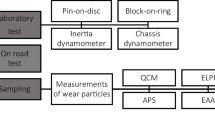Abstract
This study proposes a system that can collect and analyze the brake particle matter generated from a vehicle and brake dynamometer. A dust cover is developed to collect brake particle matter, and the number of particle matter by size is measured using a portable aerosol spectrometer. Brake PM10 generated when the vehicle is driving on highways, country and city roads is collected and analyzed. Based on the vehicle driving data, the test mode for the brake dynamometer is developed using the relationship between brake energy and brake power. The same brake fine dust collection and measurement system as the vehicle is installed on the brake dynamometer, and brake PM10 generated according to the test mode for each road condition is collected and analyzed. As a result, the total number of brake PM10 collected from the vehicle and brake dynamometer shows about maximum of 20% error rate for each road condition. The Pearson correlation coefficient for the test results is 0.9988, and it means that the vehicle and brake dynamometer test results has a strong positive relationship.















Similar content being viewed by others
Data availability
The data that support the findings of this study are available from the corresponding author, Sungpil Jung, upon reasonable request.
References
Augsburg, K., Hesse, D., Feißel, T., & Wenzel, F. (2019). Real driving emissions measurement of brake dust particles. 9th Int. Munich Chassis Symp., Munich, Germany.
Diapouli, E., Manousakas, M., Vratolis, S., Vasilatou, V., Maggos, Th., Saraga, D., Grigoratos, Th., Argyropoulos, G., Voutsa, V., Samara, C., & Eleftheriadis, D. (2017). Evolution of air pollution source contribution over one decade, derived by PM10 and PM2.5 source appointment in two metropolitan urban areas in Greece. Atmospheric Environment, 164, 416–430.
Gramstat, S., Cserhati, A., Schroeder, M., & Lugovyy, D. (2017). Brake particle emission measurements-testing method and results. SAE International Journal of Engines, 10(4), 1841–1846.
Gramstat, S., Hascoet, M., Rocca-Serra, C., & Adamczak, L. (2020a). Potentials and challenges of a brake particle emission collecting system. SAE Paper No. 2020-01-1635.
Gramstat, S., Mertens, T., Waninger, R., & Lugovyy, D. (2020b). Impacts on brake particle emission testing. Atmosphere, 11(10), 1132.
Harrison, R., Jones, A., Gietl, J., Yin, J., & Green, D. (2012). Estimation of the contributions of brake dust, tire wear, and resuspension to non-exhaust traffic particles derived from atmospheric measurements. Environmental Science Technology, 46(12), 6523–6529.
Huber, M. P., Fischer, P., Mamakos, A., Steiner, G., & Klug, A. (2022). Measuring brake wear particles with a real-driving emissions sampling system on a brake dynamometer. SAE Paper No. 2022-01-1180.
Hwang, I., & Lee, Y. (2021). A study on the pressure drop characteristics of a passive filter system for collecting fine brake dust. International Journal of Automotive Technology, 22(5), 1257–1265.
ISO 12219-1. (2021). Interior air of road vehicles—part 1: Whole vehicle test chamber—Specification and method for the determination of volatile organic compounds in cabin interiors. International Organization for Standardization.
IWG. (2021). Non-exhaust brake emissions-Laboratory testing-Part1: Inertia dynamometer protocol to measure and characterize brake emissions using the WLTP-brake cycle. Informal Document GRPE-81-12.
IWG. (2023). Terms of references and rules of procedure for the informal working group on the particle measurement programme. Informal Document GRPE-83-27.
Mathissen, M., Grochowicz, J., Schmidt, C., Vogt, R., Hagen, F., Grabiec, T., Steven, H., & Grigoratos, T. (2018). A novel real-world braking cycle for studying brake wear particle emissions. Wear, 414, 219–226.
Oroumiyeh, F., & Zhu, Y. (2021). Brake and tire particles measured from on-road vehicles: Effects of vehicle mass and braking intensity. Atmospheric Environment: X, 12, 100121.
Perricone, G., Alemani, M., Wahlström, J., & Olofsson, U. (2020). A proposed driving cycle for brake emissions investigation for test stand. Proceedings of the Institution of Mechanical Engineers, Part d: Journal of Automobile Engineering, 234(1), 122–135.
The World Bank. (2021). Urban Population (% of total population). https://data.worldbank.org/indicator/SP.URB.TOTL.IN.ZS. Accessed 3 Jun 2023
United States Environmental Protection Agency (USEPA). (2023). Health and Environmental Effects of Particulate Matter. https://www.epa.gov/pm-pollution/health-and-environmental-effects-particulate-matter-pm. Accessed 3 Jun 2023
Wang, Y., Yin, H., Yang, Z., Su, S., Hao, L., Tan, J., Wang, X., Niu, Z., & Ge, Y. (2022). Assessing the brake particle emissions for sustainable transport: A review. Renewable and Sustainable Energy Reviews, 167, 112737.
Woo, S. H., Jang, H., Lee, S. B., & Lee, S. (2022). Comparison of total PM emissions emitted from electric and internal combustion engine vehicles: An experimental analysis. Science of the Total Environment, 842, 156961.
World Health Organization (WHO). (2023). Air Pollution Data Potal. https://www.who.int/data/gho/data/themes/air-pollution. Accessed 3 Jun 2023
zum Hagen, F. H. F., Mathissen, M., Grabiec, T., Hennicke, T., Rettig, M., Grochowicz, J., Vogt, R., & Benter, T. (2019). On-road vehicle measurements of brake wear particle emissions. Atmospheric Environment, 217, 116943.
Acknowledgements
This study was supported by the Ministry of Trade, Industry, and Energy and the Korea Evaluation Institute of Industrial Technology (KEIT) in 2019 (P20003587, Measurement and evaluation system of the fine dust from automotive nonexhaust).
Author information
Authors and Affiliations
Corresponding author
Additional information
Publisher's Note
Springer Nature remains neutral with regard to jurisdictional claims in published maps and institutional affiliations.
Rights and permissions
Springer Nature or its licensor (e.g. a society or other partner) holds exclusive rights to this article under a publishing agreement with the author(s) or other rightsholder(s); author self-archiving of the accepted manuscript version of this article is solely governed by the terms of such publishing agreement and applicable law.
About this article
Cite this article
Jung, S., Nam, C., Lee, P. et al. Comparative Study on Brake PM10 Emissions of Vehicle and Brake Dynamometer Under Different Road Conditions. Int.J Automot. Technol. 25, 71–82 (2024). https://doi.org/10.1007/s12239-024-00012-y
Received:
Revised:
Accepted:
Published:
Issue Date:
DOI: https://doi.org/10.1007/s12239-024-00012-y




